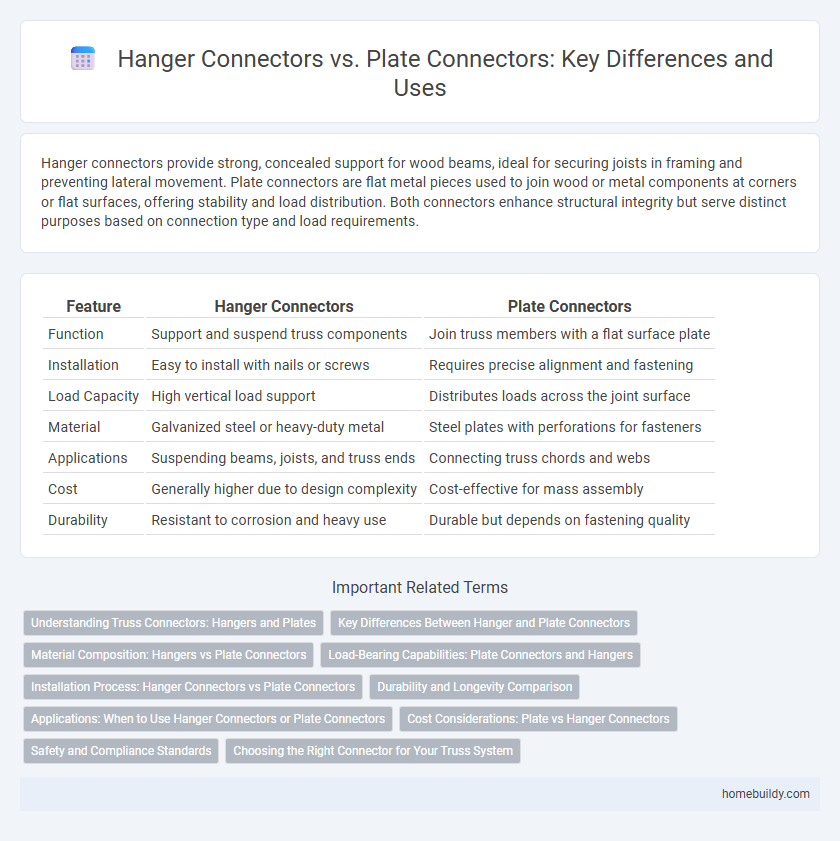Hanger connectors provide strong, concealed support for wood beams, ideal for securing joists in framing and preventing lateral movement. Plate connectors are flat metal pieces used to join wood or metal components at corners or flat surfaces, offering stability and load distribution. Both connectors enhance structural integrity but serve distinct purposes based on connection type and load requirements.
Table of Comparison
| Feature | Hanger Connectors | Plate Connectors |
|---|---|---|
| Function | Support and suspend truss components | Join truss members with a flat surface plate |
| Installation | Easy to install with nails or screws | Requires precise alignment and fastening |
| Load Capacity | High vertical load support | Distributes loads across the joint surface |
| Material | Galvanized steel or heavy-duty metal | Steel plates with perforations for fasteners |
| Applications | Suspending beams, joists, and truss ends | Connecting truss chords and webs |
| Cost | Generally higher due to design complexity | Cost-effective for mass assembly |
| Durability | Resistant to corrosion and heavy use | Durable but depends on fastening quality |
Understanding Truss Connectors: Hangers and Plates
Hanger connectors provide superior support by suspending truss members, making them ideal for load-bearing applications requiring vertical alignment and stability. Plate connectors, typically metal plates with pressed teeth, offer efficient fastening by securing multiple truss components at joints, enhancing structural integrity through distributed load transfer. Selecting between hanger and plate connectors depends on specific engineering requirements such as load capacity, installation constraints, and the desired truss design.
Key Differences Between Hanger and Plate Connectors
Hanger connectors are designed to support loads by suspending truss components, providing vertical load transfer, whereas plate connectors secure truss elements by fastening them directly to each other, ensuring lateral stability. Hanger connectors typically allow for easier installation and adjustment due to their hook-like design, while plate connectors require precise alignment and fastening, often using nails or screws. The choice between hanger and plate connectors depends on the structural requirements, load direction, and ease of assembly in truss construction.
Material Composition: Hangers vs Plate Connectors
Hanger connectors typically consist of galvanized steel for corrosion resistance and enhanced load-bearing capacity, ensuring strong vertical support in truss systems. Plate connectors are commonly made from high-strength steel with a zinc coating to prevent rust, providing robust lateral stability and shear transfer between truss members. The distinct material compositions of hangers and plate connectors directly affect their performance in structural applications, optimizing durability and safety.
Load-Bearing Capabilities: Plate Connectors and Hangers
Plate connectors provide superior load-bearing capabilities due to their larger surface area and ability to distribute loads evenly across truss joints, making them ideal for heavy structural applications. Hanger connectors primarily support vertical loads by suspending truss members, offering excellent load transfer efficiency in tension but limited resistance to lateral forces. Choosing between plate and hanger connectors depends on specific load requirements, with plates favored for compressive and combined loads while hangers excel in pure tension scenarios.
Installation Process: Hanger Connectors vs Plate Connectors
Hanger connectors typically require fewer fasteners and allow for quicker alignment during installation, making them ideal for rapid assembly in steel truss frameworks. Plate connectors demand precise positioning and multiple fasteners, increasing installation time but providing enhanced load distribution and joint stability. Selecting between hanger and plate connectors often depends on project timelines and structural performance requirements.
Durability and Longevity Comparison
Hanger connectors typically offer superior durability due to their robust steel construction and resistance to shear forces, making them ideal for heavy load-bearing applications. Plate connectors, while often easier to install, may not provide the same longevity under high-stress conditions because of potential metal fatigue and corrosion over time. Choosing hanger connectors can significantly extend the lifespan of truss systems in environments exposed to dynamic loads and moisture.
Applications: When to Use Hanger Connectors or Plate Connectors
Hanger connectors excel in applications requiring suspension of truss members, providing strong vertical support for roof joists or ceiling frameworks. Plate connectors are ideal for securing truss joints and distributing loads across flat surfaces in wall frames or floor truss connections. Choosing between hanger and plate connectors depends on structural load direction and connection type, with hangers suited for load-bearing suspension and plates optimal for shear and compression resistance.
Cost Considerations: Plate vs Hanger Connectors
Hanger connectors typically incur higher costs due to their specialized design and installation requirements, making them less economical for large-scale projects. Plate connectors offer a more cost-effective solution by being easier to manufacture and install, reducing labor and material expenses. Evaluating project budget constraints and structural needs is crucial when choosing between plate and hanger connectors.
Safety and Compliance Standards
Hanger connectors provide superior safety by securely supporting truss loads in compliance with ASTM D5756 standards, minimizing the risk of structural failure. Plate connectors, often used for gusseting, must meet rigorous building codes such as ICC-ES ESR-1360 to ensure proper load distribution and prevent joint separation. Both types require adherence to manufacturer specifications and local compliance regulations to guarantee structural integrity and occupant safety.
Choosing the Right Connector for Your Truss System
Hanger connectors provide superior load-bearing capacity and are ideal for supporting heavy truss systems with vertical or angled loads. Plate connectors offer a cost-effective solution for light to moderate loads, ensuring fast installation with metal plate fasteners embedded in the truss webs. Selecting the right connector depends on load requirements, installation speed, and structural design to optimize truss performance and safety.
Hanger connectors vs plate connectors Infographic

 homebuildy.com
homebuildy.com